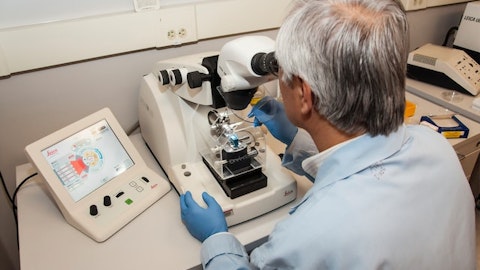As I mentioned in my comments earlier on, 729 has shown activity on all three of the components we believe are necessary for a functional cure, reducing HBV DNA, reducing surface antigen, and reawakening the immune system. And 729 is the only RNAi that’s generated data showing dosage intervals of either monthly, every eight weeks, or every 12 weeks. So we have, built in some dosage flexibility moving forward. And then, Mike, you might want to just comment upon the single trigger aspect and any of the preclinical differences.
Michael Sofia: Yes, so preclinically, if you look at imdusiran, right, it’s a single trigger agent, which cannot get all viral transcripts with one siRNA, including integrated transcripts that comes off of the host genome. One of the challenges with the J&J asset is that it requires two siRNAs to be able to accomplish what we’re able to accomplish with one. So I think there’s a big difference in when you look at cost of goods and feasibility of commercialization of those two different assets. They were a lower dose than they are as well. So there is, I think, a differentiating profile for imdusiran versus the J&J siRNA.
Unidentified Analyst: Great, thank you. That’s very helpful.
Operator: Thank you, and one moment for our next question. Our next question comes from Thomas Yip of H.C. Wainwright. Your line is now open.
Thomas Yip: Hi, good afternoon, everyone. Good morning. Sorry about that. Thank you for taking our questions. Asking a couple of questions for us. First of all, I just want to say, Bill, Pat and I both have the honor of working with you and best of luck in your future endeavors. And, yes it’s kind of close by surprise. But first, perhaps the first question from the extended cohort, from the Q2 study, the one with low dose nivolumab. Perhaps can you provide more specific timeframe for this preliminary readout? Should we expect something in the first half of the year? And then also, how many weeks of treatment data can we expect from this preliminary data set?
Bill Collier: All right. Thomas, thank you very much for your well wishes. I appreciate that. Yes, so this additional arm that we’ve included in the 202 study that includes Nivo, obviously we announced that, a good time after we started the original study design. So it is running on a later time track. As we’ve announced, we have started dosing in that arm. So that arm is underway. We’ve not yet disclosed when we’re likely to get data from that specific arm. I mean, I would point to the fact that most years, we normally do a press release with our kind of expectations early in January, and that might be another time to ask you a question
Thomas Yip: Got it. And then perhaps pertaining to this preliminary rate. Can you discuss what would be your seg a point that you will consider to be a successful trend.
Bill Collier: Karen?
Karen Sims: Sure absolutely. So as we’ve discussed, our goal certainly is to look for functional cure and hepatitis speed, certainly, there’ll be interim steps readouts that will have to be taken before we get subjects to functional cures. So for this particular data set contains be looking at surface antigen decline based on the industry and leading period, which is 24 weeks of reduced treatment prior to remeasure either the VTP-300 immunotherapeutic or placebo. So certainly looking for imdusiran contribution to lower surface antigen during this lead-in period and then certainly, any impact to that VTP-300 has in terms of maintaining that service management decline, increasing that surface antigen decline and certainly anything related to additional immunomodulatory impacts in addition to what we have served previously with imdusiran on its own.
So I think those are what we’ll be looking for in this data readout that’s coming up at ASLD unfortunately, still under embargo, so I can’t share any of the details of that. But to be disclosed in the next few days as the conference begins.
Thomas Yip: Okay. Perhaps just 1 more question from us for AB-101 can you talk about how far and long the enrollment for each of the 3 parts? And if especially data for the third quarter in patients at data positive any possibility to those 101 combination with imdusiran as we have seen in the expansion cohort?




